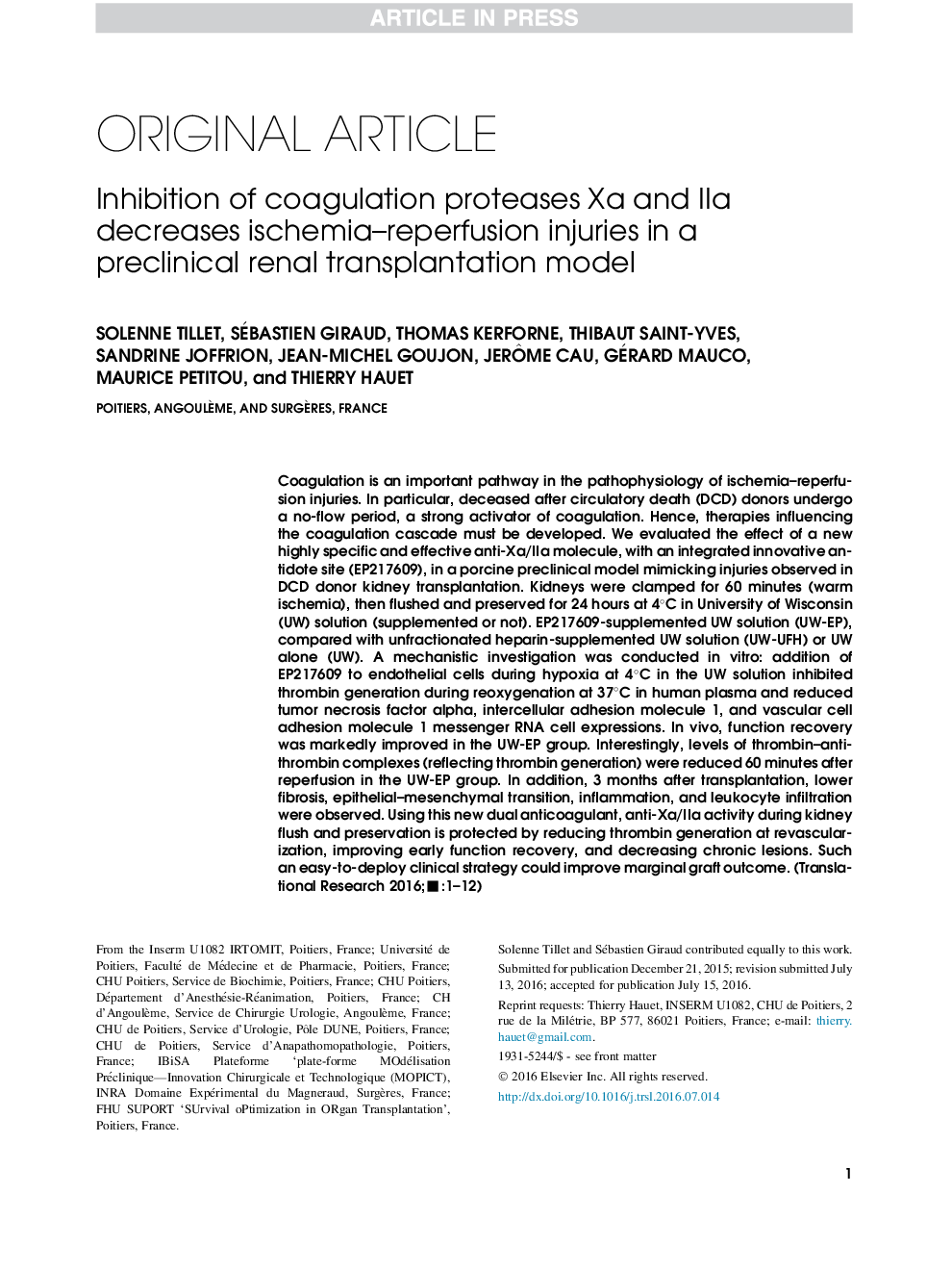| Article ID | Journal | Published Year | Pages | File Type |
|---|---|---|---|---|
| 5685120 | Translational Research | 2016 | 13 Pages |
Abstract
Coagulation is an important pathway in the pathophysiology of ischemia-reperfusion injuries. In particular, deceased after circulatory death (DCD) donors undergo a no-flow period, a strong activator of coagulation. Hence, therapies influencing the coagulation cascade must be developed. We evaluated the effect of a new highly specific and effective anti-Xa/IIa molecule, with an integrated innovative antidote site (EP217609), in a porcine preclinical model mimicking injuries observed in DCD donor kidney transplantation. Kidneys were clamped for 60 minutes (warm ischemia), then flushed and preserved for 24 hours at 4°C in University of Wisconsin (UW) solution (supplemented or not). EP217609-supplemented UW solution (UW-EP), compared with unfractionated heparin-supplemented UW solution (UW-UFH) or UW alone (UW). A mechanistic investigation was conducted in vitro: addition of EP217609 to endothelial cells during hypoxia at 4°C in the UW solution inhibited thrombin generation during reoxygenation at 37°C in human plasma and reduced tumor necrosis factor alpha, intercellular adhesion molecule 1, and vascular cell adhesion molecule 1 messenger RNA cell expressions. In vivo, function recovery was markedly improved in the UW-EP group. Interestingly, levels of thrombin-antithrombin complexes (reflecting thrombin generation) were reduced 60 minutes after reperfusion in the UW-EP group. In addition, 3 months after transplantation, lower fibrosis, epithelial-mesenchymal transition, inflammation, and leukocyte infiltration were observed. Using this new dual anticoagulant, anti-Xa/IIa activity during kidney flush and preservation is protected by reducing thrombin generation at revascularization, improving early function recovery, and decreasing chronic lesions. Such an easy-to-deploy clinical strategy could improve marginal graft outcome.
Keywords
α-SMAMMP-2MCP-1iNOSPAI-1ICAM-1GAPDHTGF-βDCDFBSUFHVCAM-1HESα-smooth muscle actinischemia–reperfusionHAECinterleukinTATTransforming growth factor βPartumor necrosis factor alphaEMTUniversity of Wisconsinfetal bovine serumhuman aortic endothelial cellinducible nitric oxide synthaseTissue factorIrisTNF-αmatrix metalloproteinase 2Intercellular adhesion molecule 1Vascular cell adhesion molecule 1NEPunfractionated heparinmonocyte chemoattractant protein 1plasminogen activator inhibitor type-1Epithelial–mesenchymal transitionglyceraldehyde 3-phosphate dehydrogenaseprotease-activated receptor
Related Topics
Health Sciences
Medicine and Dentistry
Medicine and Dentistry (General)
Authors
Solenne Tillet, Sébastien Giraud, Thomas Kerforne, Thibaut Saint-Yves, Sandrine Joffrion, Jean-Michel Goujon, Jerôme Cau, Gérard Mauco, Maurice Petitou, Thierry Hauet,
